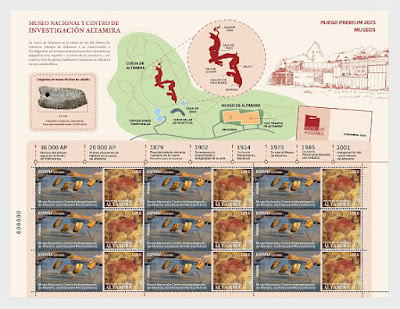3844) The National Museum and Research Center of Altamira (Spanish: Museo Nacional y Centro de Investigación de Altamira), Spain: Date/Year of Stamp issue: 27.03.2025:
The National Museum and Research Center of Altamira (Spanish: Museo Nacional y Centro de Investigación de Altamira), also known as Altamira Museum (Spanish: Museo de Altamira), is a centre dedicated to the conservation of, research into, and the sharing of information about the Cave of Altamira in Santillana del Mar (Cantabria), Spain, named a World Heritage Site by UNESCO.
The Museum was created in 1979. It is one of the National Museums of Spain and it is attached to the Ministry of Culture.
The cave of Altamira was declared a World Heritage Site (UNESCO) in 1985:
Adds the Book titled "TREASURES OF THE WORLD - a complete guide to the UNESCO World Heritage Sites" in my personal Library/Collection:
"Altamira, the Sistine Chapel of Prehistory, is a unique asrtistic achievement and bears exceptional testimony to the Magdalenian cultures of southern Europe around 15,500 years ago.
Discovered by chance in 1869. the Cave of Altamira revealed the existence of two very rich archeological levels.
It was inhabited as early as the Aurignacian, the date of the first figurative representations depicted on its walls, around 18,500 years ago.
It was at the start of the Magdalenian period that the largest room in the cavern was decorated. Under its vault there are superb paintings of bison, horses, deer and boars using a palette of colours consisting of only a small number of shades (ochre, reds and blacks).
In 2008, seventeen decorated caves, representing the apogee of Paleilithic cave art that developed across Europe, from the Urals to the Iberian Peninusula, from 35,000 to 11,000 BC, were inscribed to the Altamira Cave site.
With deep galleries, and isolated from external climatic influences, these caves are particularly well preserved.
The large animal images (the doe is 2.2 metres long) are striking in their naturalism, and their specific features are scrupulously reproduced.
They are also outstanding in the variety of fur and mane textures, which are extyremely well rendered, and the variety of poses which make masterly use of the cave's surface and crevices that provide surprising trompel'ceil efftects".
The Museum:
The museum offers prehistoric technology workshops to visitors, as well as a permanent exhibition called "Times of Altamira", which contains objects from Altamira as well as those from other palaeolithic caves of Cantabria such as El Morín [es], El Juyo and El Rascaño [es].
The New Altamira Cave, or Neocave [es], is also part of this exhibition: an artificial replica of the original caves, built in order to preserve the originals from damage arising from a massive influx of visitors.
The vast number of people that wanted to see the cave and the long wait list to do it (more than a year) brought into the table the possibility and necessity of creating a replica.
In 2001, the Museum, designed by architect Juan Navarro Baldeweg was erected. The most notable piece in the museum collection is the Neocave [es], the most faithful representation of the 15000 year old original cave.
In its interior one can see a reproduction of the famous paintings from the cave's ceiling, made by Pedro Saura and Matilde Múzquiz, professors of photography and drawing in the Faculty of Fine Arts [es] of the Complutense University of Madrid, respectively.
In this reproduction, the same painting techniques used by painters in the Paleolithic were used. The reproduction was so deeply planned and studied that, during the study of the originals, new paintings and engravings were discovered.
It is a National Museum of Spain [es], subscribed to the Ministry of Education, Culture and Sports, managed by the General direction of Fine Arts [es].
Various collections are custodied and displayed, from discoveries in the Cave of Altamira and others nearby, such as:
Cave of Altamira (Santillana del Mar, Cantabria).
Surroundings of Altamira (Santillana del Mar, Cantabria).
Archeological site of Cuchía (Cuchía [es], Miengo, Cantabria).
Cave of El Castillo (Puente Viesgo, Cantabria).
Cave of El Morín [es] (Villanueva de Villaescusa [es], Cantabria).
Cave of El Rascaño [es] (Mirones [es], Miera, Cantabria).
Cave of El Salitre [es] (Ajanedo [es], Miera, Cantabria).
Cave of Chufín (Riclones [es], Cantabria).
Cave of Juyo (Igollo de Camargo [es], Cantabria).
Cave of La Pila (Cuchía [es], Miengo, Cantabria).
Cave of Las Estalactitas (Santillana del Mar, Cantabria).
Other outdoor paleolithic sites.
The Stamps:
The Altamiri Cave Stamps of 1.85 Euro
The First Day Cover (FDC)
Links:
The Clipper - Cutty Sark:


